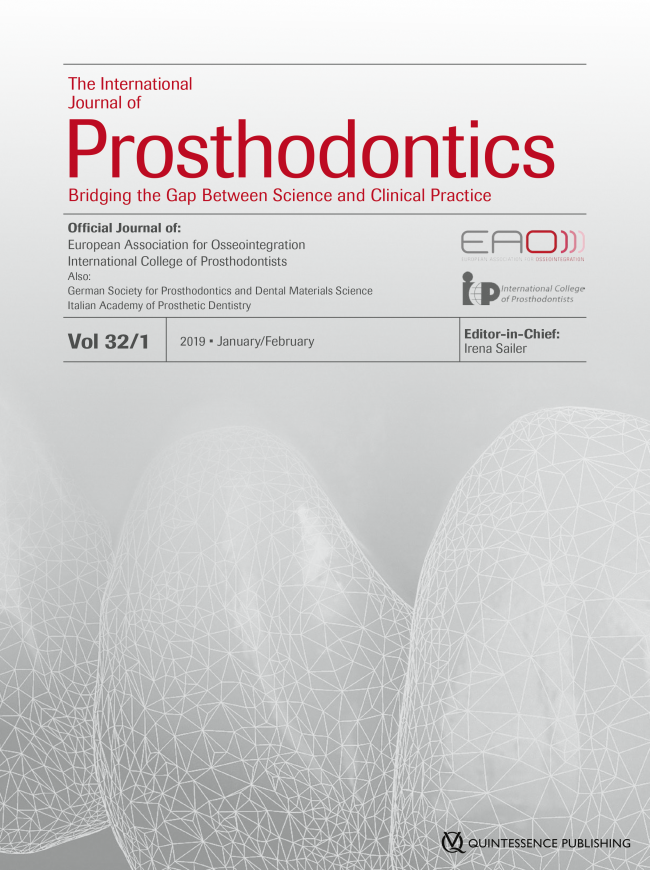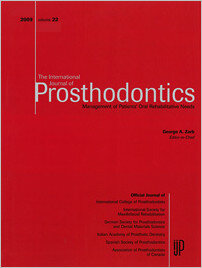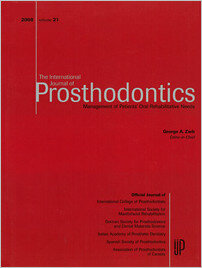Pages 7, Language: EnglishZarb, George A.PubMed ID (PMID): 20297557Pages 8-9, Language: EnglishStanford, ClarkPubMed ID (PMID): 20234886Pages 13-21, Language: EnglishLiddelow, Glen / Henry, PatrickPurpose: The aim of this study was to ascertain whether simplifying mandibular overdenture treatment by using single-stage surgery and immediate prosthetic loading of a single implant will achieve acceptable implant success rates, functional improvement, and increased patient satisfaction. As part of this study, the Mk III Brånemark implant with an oxidized surface was compared to the classic machined Mk III Brånemark implant.
Materials and Methods: Thirty-five patients (mean age: 68 years) with problematic mandibular dentures were treated. The primary complaints among the patients referred to the clinic for treatment were poor retention of the mandibular denture, instability, denture sores, and phonetic problems. Initially, patients were placed randomly into the "machined surface" or "oxidized surface" groups. A single implant was placed in the mandibular midline with high initial stability. A ball attachment was placed and the retentive cap incorporated into the existing denture. Reviews took place at 3, 12, and 36 months posttreatment. Clinical assessments, radiographs made with custom film holders, and stability measurements by both manual and resonance frequency analysis methods were recorded. All complications, failures, maintenance, and reasons for dropout were noted. Visual analog scale questionnaires were used to record patient satisfaction (analysis of variance: P .05).
Results: Three of eight machined-surface implants failed, representing an unacceptably high failure rate (37.5%). The machined surface was therefore discontinued for this study. One machined and two oxidized-surface implants did not achieve sufficient primary stability to be immediately loaded, so they were treated with a two-stage delayed loading protocol. The 25 immediately loaded oxidized-surface implants were all classified as surviving at the 36-month recall. Patient satisfaction was very high with a significant increase in all comfort and functional parameters.
Conclusions: Within the limitations of this study and research design, it appears that over a 3-year observation period, the immediately loaded single implant-retained mandibular overdenture, using an oxidized-surface implant and the existing prosthesis in a small group of prosthetically maladaptive patients, can provide a beneficial treatment outcome with a minimal financial outlay.
PubMed ID (PMID): 20234887Pages 22-28, Language: EnglishWeinländer, Michael / Krennmair, Gerald / Piehslinger, EvaPurpose: This retrospective study assessed implant and prosthodontic treatment outcomes of patients suffering from rheumatic disorders such as rheumatoid arthritis (RA) and connective tissue diseases (CTDs).
Materials and Methods: This study included 22 patients (all women) suffering from autoimmune rheumatic disorders such as isolated RA (n = 16), RA with concomitant CTDs (n = 5), or isolated CTDs (n = 1). Overall, 89 implants were placed for rehabilitations such as single-tooth replacement (n = 8), fixed partial dentures (n = 14), complete dentures (n = 5), and overdentures (n = 2), and were evaluated after a mean of 42.6 ± 25.2 months. The cumulative implant survival and success rates and peri-implant conditions (marginal bone loss, pocket depth, Plaque Index, Gingival Index, Bleeding Index, and Calculus Index) were evaluated with a special focus on RA and CTDs. In addition, incidence and type of prosthodontic maintenance were evaluated.
Results: A high implant survival rate was noted during follow-up with a cumulative 3-year implant success rate of 96.1%. Patients with RA demonstrated acceptable marginal bone resorption (mean: 2.1 ± 0.5 mm) and good soft tissue conditions, while CTD patients showed increased bone resorption (mean: 3.1 ± 0.7 mm). This was especially noted in scleroderma patients, as were major peri-implant soft tissue alterations (Bleeding Index) in patients suffering from Sjögren syndrome.
Conclusions: A high implant and prothodontic success rate can be anticipated even for patients suffering from autoimmune rheumatic disorders such as RA and CTDs. A scrupulous maintenance program that includes optimal oral hygiene could assist in ensuring stable long-term results for CTD patients with more vulnerable soft tissue conditions.
PubMed ID (PMID): 20234888Pages 29-32, Language: EnglishSouza, Rodrigo O. A. / Lombardo, Geraldo H. L. / Pereira, Sarina M. B. / Zamboni, Sandra C. / Valera, Márcia C. / Araújo, Maria A. M. / Özcan, MutluThis study assessed alterations on bovine enamel after excessive bleaching. Coronal portions of bovine teeth (n = 30) were sectioned and divided into three groups (n = 10 per group). The coronal parts were further cut incisocervically into two halves. While one half received no bleaching (control), the other half was subjected to either one (group 1), three (group 2), or five bleaching sessions (group 3) with 35% hydrogen peroxide. The enamel surfaces were then analyzed using scanning electron microscopy and energy dispersive x-ray spectroscopy (EDS). Excessive bleaching affected the surface morphology and chemistry of the bovine enamel. EDS analysis showed the highest decrease in calcium ion percentages in groups 2 and 3 when compared to their nonbleached halves. Oxygen and phosphorus percentages were comparable on both the control and bleached enamel, regardless of the number of bleaching sessions. Consecutive bleaching sessions with 35% hydrogen peroxide may lead to morphologic and specific elemental changes when performed in a short period of time. Calcium ion percentages may decrease when this bleaching agent is used for more than one session.
PubMed ID (PMID): 20234889Pages 33-37, Language: EnglishGómez-Polo, Miguel / Bartens, Fabricio / Sala, Leticia / Tamini, Faleh / Celemín, Alicia / Del Rio, JaimePurpose: The crown-implant ratio is defined as the physical relationship between each individual restoration's parts located both inside and outside the bone. This relationship represents the physical concept of a type I lever, which may be of biomechanical importance in implant treatment outcomes.
Materials and Methods: Specific patient data related to fixed implant prostheses were retrieved and studied in an effort to clinically and radiographically correlate crown-implant ratios.
Results: Recorded marginal bone resorption around implants (2.11 ± 1.30 mm) at the end of a defined observation period did not correlate with the measured crown-implant ratio, which yielded values between 0.43 and 1.5 mm (P > .05).
Conclusion: The mechanical determinants of implant success or failure are still not defined. It has been postulated that an increase in both crown-tooth, and comparably crown-implant, ratios would lead to a resultant increase in the magnitude of nonaxial forces transmitted to the tooth or implant. This could then lead to an increased vulnerability of either tooth or implant abutments to supporting bone loss. However, additional factors appear to impact long-term bone maintenance behavior around either type of abutment. Within the limited scope of this study, crown-implant ratios were not associated with recorded peri-implant bone loss.
PubMed ID (PMID): 20234890Pages 38-41, Language: EnglishYoda, Nobuhiro / Yokoyama, Masayoshi / Adachi, Genki / Takahashi, Masatoshi / Sasaki, KeiichiThe retentive force of a wire clasp composed of a ß-type Ti-6Mo-4Sn alloy (ß-Ti alloy) with a low Young modulus was evaluated using a piezoelectric transducer to determine the appropriate undercut for removable partial dentures. There were no significant differences in retentive force between a ß-Ti alloy wire with a 0.50-mm undercut and a cobalt-chromium alloy (Co-Cr alloy) wire with a 0.25-mm undercut, or between a ß-Ti alloy wire with a 0.75-mm undercut and a Co-Cr alloy wire with a 0.50- mm undercut. The ß-Ti alloy wire may be applicable for abutment teeth with a large number of undercuts.
PubMed ID (PMID): 20234891Pages 42-48, Language: EnglishMüller, Frauke / Bergendal, Birgitta / Wahlmann, Ulrich / Wagner, WilfriedPurpose: This clinical report describes the use of implant-supported fixed dental prostheses (ISFDPs) in a severe case of dystrophic epidermolysis bullosa.
Materials and Methods: The patient's appearance was characterized by reduced corporal growth and severe mutilation of the hands and feet. He was first examined at age 20. The severely decayed residual dentition had already been extracted by the time of examination. Conventional dentures were not possible due to severe microstomia and the fragility of the denture-bearing tissues. Even a modest manual touch was very painful and detached the epithelium of the oral mucosa. The first treatment was only possible under general anesthesia. To allow some prospect for oral rehabilitation, four implants were inserted in the maxilla and three in the mandible. Several years of steroid treatment had weakened the bony structures. Therefore, the diameter of the last drill used to prepare the bone for implant insertion was smaller than the diameter of the implants to improve primary stability. Complete FDPs with a shortened dental arch design served as superstructures. Several fractures in the screw-designed titanium abutments in the mandible necessitated insertion of three additional implants and an ISFDP with two occlusal units, which was screwed horizontally to a milled bar mesostructure.
Results: Despite multiple fractures of the acrylic resin veneers caused by severe bruxism and the small occlusal surface, this rehabilitation proved successful until the patient died at age 25, as a consequence of his hereditary disease.
Conclusion: This treatment greatly improved the patient's oral function, nutrition, and psychosocial well-being.
PubMed ID (PMID): 20234892Pages 49-52, Language: EnglishHu, Jun / Zhu, QingdangPurpose: The aim of this study was to investigate the effect of Prime & Bond adhesive on preventing postcementation hypersensitivity of vital abutment teeth restored with a full-coverage restoration using the immediate dentin sealing (IDS) technique.
Materials and Methods: Twenty-five male patients received 25 three-unit fixed partial dentures. A split-mouth design was used and two vital abutment teeth in each patient were allocated randomly into Groups A or B. Teeth in Group A were treated with Prime & Bond using the IDS technique while teeth in Group B were used as a control and left untreated. The discomfort interval scale, ranging from 0 to 4, was adopted to evaluate hypersensitivity. The double-blind method was applied during the operation so that neither the patient nor the clinician knew which abutment had been treated. The sensitivity assessment was performed 1 week, and 1, 6, 12, and 24 months after cementation. Results were analyzed using the sign test.
Results: Scores for teeth in Group A were statistically significantly lower than those in Group B at 1 week and 1 month postcementation (P .05), whereas there was no significant difference between Groups A and B at the end of 6, 12, and 24 months (P > .05).
Conclusion: Preventive treatment with Prime & Bond using the IDS technique can significantly reduce postcementation hypersensitivity.
PubMed ID (PMID): 20234893Pages 53-55, Language: EnglishTakayama, Yoshiyuki / Sasaki, Hiroko / Goto, Marie / Mizuno, Kentaro / Saito, Masayasu / Yokoyama, AtsuroThe aim of this study was to determine the morphologic factors that characterize mandibular edentulous alveolar ridges. The shapes of casts and waxed complete dentures were digitally scanned and the extracted shapes of the ridges were uniformly divided both mesiodistally and buccolingually. Principal component analysis was performed using the coordinates of the points on the grid as variables. Over 82% of the variables could be expressed using seven principal components. However, some of these were not taken into account by the existing criteria. Therefore, the influence of each principal component should be investigated.
PubMed ID (PMID): 20234894Pages 56-59, Language: EnglishMitsias, Miltiadis E. / Silva, Nelson R. F. A. / Pines, Mitchel / Stappert, Christian / Thompson, Van P.The fracture strength and accelerated fatigue reliability of metal and zirconia abutment systems were tested. Implants with either titanium (Ti, n = 9) or zirconia abutments (Zr, n = 18) were restored with metal crowns. Loads were applied as either a monotonic load to failure or mouth-motion cycles using a step-stress accelerated life testing method. At failure, monotonic loads were 1,475 ± 625 N for Ti and 690 ± 430 N for Zr. In step-stress testing, the Ti group was truncated at 70,000 cycles and a 900-N load with no fractures. In the Zr group, eight specimens survived and seven failed, with a maximum load of 400 N. Strength and reliability were significantly higher for the Ti abutments compared to the Zr.
PubMed ID (PMID): 20234895Pages 60-62, Language: EnglishKassem, Amr Shebl / Atta, Osama / El-Mowafy, OmarThe aim of this study was to identify recent studies that dealt with the clinical performance of porcelain molar crowns and to explore the possibility of grouping the findings from similar studies together to draw overall conclusions. A MEDLINE literature search was conducted in early 2009 covering the preceding 12 years. Seventeen studies were indentified. However, only seven met the specific inclusion criteria and were analyzed. Among seven studies, five European countries were covered. Five studies reported on Procera AllCeram molar crowns while one reported on In-Ceram Alumina and Spinell crowns and another on CEREC crowns. For comparison, one additional study that reported on premolar crowns was included. In the five Procera AllCeram studies, 235 molar crowns were evaluated for 5 or more years, of which 24 failed. When the results of the five studies on the performance of Procera AllCeram molar crowns were considered collectively, an overall failure rate of 10.2% was found at 5 or more years.
PubMed ID (PMID): 20234896Pages 63-68, Language: EnglishDittmer, Marc Philipp / Kohorst, Philipp / Borchers, Lothar / Stiesch, MeikePurpose: The aim of this study was to investigate the influence of the design and material composition of the supporting structure of a zirconia four-unit fixed partial denture (FPD) on stress distribution during in vitro loading.
Materials and Methods: A three-dimensional finite element model of an all-ceramic FPD ranging from the maxillary left first premolar to second molar was constructed. The supporting structures were modeled in four versions. In version 1, the socket and rigidly fixed abutment teeth were made of a nickel-chromium (Ni-Cr) alloy. Version 2 was similar to version 1 but abutment teeth were embedded resiliently. Version 3 replaced the Ni-Cr alloy with polyurethane as the material for the socket and abutment teeth. Version 4 was designed according to the in vivo situation with a simulated periodontal ligament, the socket consisting of spongiosa, and abutment teeth composed of dentin. An occlusal force of 1,630 N was distributed over the marginal ridges of the pontics.
Results: The highest tensile stresses were located within the framework underneath the connector between the second premolar and first molar and ranged between 289 and 633 MPa, according to the model version. The resilient support of abutment teeth resulted in considerably higher maximum tensile stresses.
Conclusions: The choice of material for abutment teeth and the socket, as well as the type of tooth support, significantly influence stresses generated in FPDs during in vitro load tests. To achieve realistic results, FPDs should be supported by resiliently embedded abutment teeth made of a moderately rigid material (eg, polyurethane). In clinical practice, risk of failure is likely to rise with an increasing resilience of the abutment teeth if occlusal contacts are directed over the pontic/connector region rather than being spread over the retainers.








